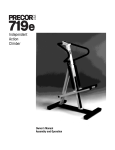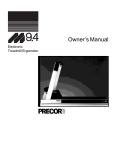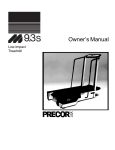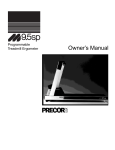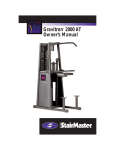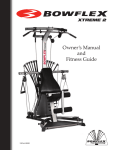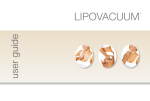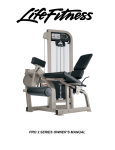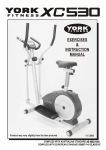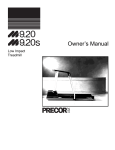Download Manual Treadmill
Transcript
USA R Manual Treadmill Owner’s Manual Assembly and Operation USA R Thank you for purchasing one of the innovative additions to the famous Precor treadmill line. The 903 Manual Treadmill provides you with a safe and effective workout. Manual Treadmill Before using the 903 Manual Treadmill, we urge you to familiarize yourself with the entire Owner’s Manual. Whether you are a beginner or exercise on treadmills regularly, understanding this manual will help you use the 903 treadmill safely and successfully. Safety Information Please review and observe the following safety guidelines: CAUTION: Before beginning any fitness program, you should have a complete physical examination by your physician. • Read the Owner’s Manual and follow all instructions. • Assemble and operate the 903 treadmill on a solid, level surface. Locate the treadmill a few feet from walls or furniture. Keep the area behind the treadmill clear. • Do not allow children on or near the 903 treadmill. Do not leave children unsupervised around the treadmill. • Check the 903 treadmill before each use. Be sure all assembly bolts and T-knobs are tightened and secure. Do not use the treadmill if it is not completely assembled or is damaged in any way. • Keep hands away from the flywheel and other moving parts. • Wear proper exercise clothing and shoes for your workout—no loose clothing. Do not wear shoes with heels or leather soles. Check the soles of your shoes and remove any embedded stones. Tie long hair back. • Use care and hold onto the handrail when getting on or off the 903 treadmill. • Keep your body and head facing forward. Do not attempt to turn around on the treadmill when the belt is moving. • Do not rock the unit. Do not stand or climb on the handrail. Never place liquids on any part of the treadmill. • Do not overexert yourself or work to exhaustion. • Stop your workout immediately if you feel any pain or abnormal symptoms, and consult your physician. Precor treadmills are designed for the enjoyment of the serious runner as well as the dedicated walker. By following the above precautions and using good common sense, you will have many safe and pleasurable hours of healthful exercise with your Precor treadmill. page 2 Table of Contents Unpacking the 903 Manual Treadmill ......................................................... 4 Assembling the 903 Manual Treadmill ..................................................... 5 Installation Requirements .................................................................... 5 Assembly Instructions ......................................................................... 5 Adjusting the Elevation Tube ............................................................... 7 Checking the Alignment of the Running Belt ....................................... 9 Using the Precor 903 Manual Treadmill. ................................................... 10 Beginning Your Workout ..................................................................... 10 Ending Your Workout .......................................................................... 10 Working Out on the 903 Treadmill ....................................................... 10 Adjusting the Resistance Level ............................................................ 12 General Aerobic Training Information ....................................................... 13 How Hard Should I Exercise? .............................................................. 14 How Long Should I Exercise? .............................................................. 15 How Often Should I Exercise? ............................................................. 15 Maintaining the 903 Manual Treadmill ..................................................... 16 Cleaning the Treadmill ......................................................................... 16 Storing the Treadmill ........................................................................... 16 Aligning the Running Belt .................................................................... 17 Lubricating the Running Belt ............................................................... 19 Obtaining Service ................................................................................ 19 page 3 Unpacking the 903 Manual Treadmill All Precor products are thoroughly tested and inspected before shipment. Precor ships the 903 treadmill in three pieces: • deck assembly • front lift bar • hardware kit (contents described below) and literature kit Diagram 1 Unassembled 903 treadmill. Handrail Front lift bar Lift bar bracket Height adjustment pin Running belt T-knob Flywheel Side rail mount Diagram 1 shows the treadmill parts after the carton has been removed. Callouts point to the different parts of the treadmill that are discussed in the assembly instructions. Unpack the treadmill close to the location where you plan to use it. Save the triangular end blocks for use in the assembly. Open the hardware kit and make sure that you have the following items. As you identify the contents of the kit, check them off below. 2 T-knobs—handrail installation 2 washers—handrail installation CAUTION: Place the hex key in a safe and secure place. If the running belt should move off-center, you can use the 1/4" hex key to align it. page 4 1/4" hex key If any items are missing, contact your authorized Precor dealer. For the dealer nearest you, call 1-800-4-PRECOR. Important: The packaging for this equipment was designed to protect it during shipment. Please store the original packaging in a safe place in case you need to ship the 903 treadmill in the future. Assembling the 903 Manual Treadmill Follow the instructions in this section to assemble the 903 Manual Treadmill. It is important to read through the entire procedure before assembling your treadmill. If you do not assemble and use this treadmill according to the following guidelines, you could void the Precor limited warranty. Installation Requirements Follow these installation requirements when installing the treadmill: • Fill out and mail the limited warranty registration card. The serial number is written on a label underneath the treadmill on the center crossbeam. During the assembly process, write the serial number on the limited warranty card and in this Owner’s Manual (see Obtaining Service). If you want a 903 Service Manual, write to: ATTN: 903 Service Manual Precor Customer Service Department P.O. Box 3004 Bothell, WA 98041-3004 • Set up the 903 treadmill on a solid, flat surface. Do not install the treadmill on hardwood floors because the wheels might scratch or damage the surface. If the treadmill is placed on a hardwood floor or a carpeted, deep-pile surface, place a piece of heavy cardboard, plywood, or other smooth, flat surface under the unit to protect the floor and treadmill. If the floor is not flat and even, the running belt may not track properly. • Locate the treadmill at least 4 feet from walls and furniture. Open space to the front, sides, and back of the machine make for a safer mount and dismount and easier belt adjustment. Assembly Instructions To assemble the 903 treadmill, review the callouts in Diagram 1 before you take the following steps: 1. Install the Front Lift Bar assembly. (Diagram 2) With the treadmill base flat on the floor near the location where you plan to use it, take the following steps to install the front lift bar: a. Place the triangular, cardboard end blocks, set aside when you unpacked the treadmill, under the front of the unit to lift the flywheel off of the floor. b. Remove the four bolts and washers from the front lift bar and set them aside. c. Slide the front lift bar brackets into the side rail mounts. Note: You may need to ask for assistance to help you lift the front of the treadmill to align the front lift bar brackets into the side rail mounts. page 5 Diagram 2 Installing the Front Lift Bar assembly. Flywheel Running belt Washer Bolt Side rail mount Front lift bar Height adjustment pin Locking portion of pin Elevation tube d. Re-insert the bolts and washers as shown in Diagram 2. Tighten the bolts securely using the hex key provided. Diagram 3 Locking handrail into upright position. Micro adjustment knob Handrail Front lift bar Side rail T-knob Frame plate Height adjustment pin Elevation tube 2. Position the Handrail. (Diagram 3) Remove the T-knobs and washers from the hardware kit and take the following steps to secure the handrail: a. Pull the handrail into an upright position. See Diagram 3. Important: Perform the remaining steps on one side of the treadmill at a time. 3. page 6 b. Hold onto the handrail while you insert a T-knob and washer through the handrail mount (one on each side of the treadmill). Repeat this step for the opposite side. c. Align the T-knob with the hole in the side rail and tighten the T-knob by turning it clockwise. Alternately tighten the T-knobs until both washers are tight against the side rails. Adjust the incline of the treadmill and set the running belt to the proper resistance level, by following the steps in Adjusting the Elevation Tube. Adjusting the Elevation Tube The elevation tube is set at the factory at the lowest setting. To receive optimal performance, reposition the height adjustment pin by taking the following steps: 1. Determine the proper Elevation Tube setting. (Table 1) The elevation tube provides six different settings. Each setting provides a different level of resistance needed (dependent on your weight) to maintain an efficient workout. To get optimal performance from your treadmill, refer to settings shown in Table 1. To determine if you have set the proper elevation for your height, stand on the running belt with your hands on the handrail for balance. Your feet should slide slowly and easily away toward the rear of the treadmill. Continue walking and when you are comfortable and well-balanced on the treadmill, release your grip on the handrail. The running belt should continue to move freely while you maintain your momentum. If the running belt slows, stops, or becomes more difficult to walk on, consider moving the elevation tube up one more setting. Table 1 Elevation tube settings according to user’s weight. Setting #6 Setting #3 Setting #1 Elevation Tube Settings Dependent on Weight #6 #5 #4 Height adjustment pin Locking portion of pin #3 #2 Elevation tube #1 below 80 lbs 80 lbs and below 80 to 100 pounds 100 through 140 pounds 140 through 200 pounds 200 pounds (lbs) and above Note: Table 1 is an approximation and elevation tube settings may vary slightly depending on differences in weight and the amount of lubrication between the running belt and deck. Over time and extended use, you may need to readjust the elevation tube setting. Remember that you want to be able to maintain your momentum on the running belt without having to push off from the handrail. A lubrication kit, available from your local dealer, can be used as the equipment ages or friction (between the running belt and deck) increases. If you do lubricate the deck, you may need to change the elevation setting. See Obtaining Service for more information. page 7 Diagram 4 Placing treadmill onto front lift bar. Micro-adjustment knob Front lift bar Running belt Handrail CAUTION: Be sure that the T-knobs are secure and locked into position on both sides of the handrail before performing this step. 2. Position the Treadmill on Its Side. (Diagram 4) Place your hands on either side of the handrail and gently tip the treadmill onto its side opposite the micro-adjustment knob. See Diagram 4. Be sure the treadmill is balanced and secure on its side and the micro-adjustment knob is not resting on the floor, before you let go of the handrail. 3. Adjust the Elevation Tube. (Diagram 5) The elevation tube has six settings (refer to Table 1). To move the height adjustment pin to another setting, take the following steps. Diagram 5 Moving the elevation settings and height adjustment pins. Height adjustment pin Locking portion of pin Elevation tube Important: Due to the weight of the treadmill, always adjust the elevation tube while the treadmill is resting on its side. Making adjustments in this manner also alleviates the possibility of injury. CAUTION: To avoid injury, do not place your fingers between the locking portion of the height adjustment pin and the elevation tube. page 8 a. Remove the height adjustment pin by pushing up on the locking portion that wraps around the tube. Use your fingers to pull the pin out of the elevation tube hole. Repeat this step on the opposite side. See Diagram 5. Set the height adjustment pins aside. b. Slide the elevation tube so that the elevation tube and front lift bar holes align at the proper setting. Make sure that the settings are the same for both sides of the elevation tube. c. Re-insert the height adjustment pins and push down on the portion that wraps around the tube to secure the pin into position. d. Return the treadmill to an upright position, so that the base is flat on the floor. Checking the Alignment of the Running Belt Before working out on your treadmill, you need to check the alignment of the running belt. The running belt on the 903 treadmill has been fully adjusted at the factory and should track straight on the deck. However, if the running belt seems to track off center of the deck or you hear a chafing noise, check the belt alignment by taking the following steps: 1. Walk on the treadmill while holding onto the handrail for balance. 2. Observe the running belt for a couple minutes. 3. If the running belt tracks off center or the belt moves toward either flywheel, you need to align the belt. 4. If you determine that the belt needs alignment, follow the steps in Aligning the Running Belt found in the maintenance section of this manual. Once the treadmill is assembled, be sure to check the alignment of the belt periodically. Adjust the running belt as soon as it needs alignment to prevent tearing or fraying of the belt. Any damage due to improper maintenance of the running belt is not covered by the limited warranty. page 9 Using the Precor 903 Manual Treadmill In addition to providing an excellent cardiovascular workout, one of the advantages of the 903 Manual Treadmill is that it is simple to use. With very little time or practice, you can learn how to use it effectively. This section provides information about the following areas: • beginning and ending your workout • working out on the treadmill • adjusting the resistance level Beginning Your Workout Prior to beginning a workout, make sure that you have completed the following: • assembled your 903 treadmill—Assembly Instructions • adjusted the elevation tube settings—Adjusting the Elevation Tube • checked the running belt alignment—Aligning the Running Belt • stretched your lower body and back—Working Out on Your 903 Treadmill If a procedure has not been fully completed, refer to that section and complete the tasks involved before beginning your workout. To begin a workout, hold onto the handrail as you step onto the running belt. Slowly, turn the micro-adjustment knob to adjust the resistance of the running belt. You should adjust the resistance so that you can walk comfortably, but maintain momentum without holding onto the handrail. For more information about working out, refer to Working Out on Your 903 Treadmill and Adjusting the Resistance Level. Ending Your Workout To end your workout, hold onto the handrail as you gradually reduce the speed of the running belt till it comes to a complete stop. Step off the running belt onto the floor. If you wish to store the treadmill, refer to the instructions found in Storing the Treadmill. Remember to incorporate a cool-down period into your workout. A cool-down period helps you to gradually lower your heart rate and lessen excessive muscle soreness or stiffness. Working Out on the 903 Treadmill CAUTION: Before beginning any fitness program, you should have a complete physical examination by your physician. page 10 Before using your treadmill, we recommend that you follow these instructions and go through a preliminary demonstration of the treadmill. Then, you will be more familiar with the treadmill when you begin your workout. When using the treadmill, follow these general guidelines: • At the beginning of a workout, take several minutes to bring your heart rate into your training zone, as shown in Diagram 8 later in this manual. • After your workout, walk slowly for several minutes to cool down your body and lower your pulse rate. • Gently stretch your lower body and back before and after a workout to help prevent stiffness or soreness. Photo 1 Working out on the 903. CAUTION: Before beginning any fitness program, you should have a complete physical examination by your physician. To use the 903 treadmill, follow these steps: 1. Hold onto the handrail and step onto the running belt. 2. Begin walking as shown in Photo 1. You should start your workout at a pace that will allow your heart rate to reach your training zone within 5 minutes. Adjust the resistance of the running belt by slowly turning the micro-adjustment knob. Turn the knob counterclockwise to increase resistance (clockwise to reduce resistance). 3. When you feel comfortable with the motion of the treadmill, let go of the handrail and continue your workout. After your initial warm-up period, maintain your heart rate in your training zone during your aerobic session. Refer to Diagram 8 later in this manual. Note: Remember to hold on to the handrail when slowing down or stopping. 4. When you are through exercising, cool down for 3 to 5 minutes by gradually reducing your belt speed. A proper cool-down helps to transport excess lactic acid out of the working muscles, allowing them to recover faster. 5. To end your workout, hold onto the handrail and stop walking or running. Let the running belt come to a complete stop before stepping onto the floor. For best results, vary your workouts by changing duration, intensity, and type of work (such as interval training). We recommend that you keep track of your workouts by writing them down; this way you can monitor your progress toward your fitness goals and also use the information as a reference in planning interesting, challenging workouts. page 11 Adjusting the Resistance Level The micro-adjustment knob on the 903 treadmill, allows adjustments that affect the movement of the running belt. Adjust the resistance while you are walking or running on the treadmill. Before using the micro-adjustment knob, make sure that you have completed the following procedures: • assembled your 903 treadmill—Assembly Instructions • adjusted the elevation tube settings—Adjusting the Elevation Tube • checked the running belt alignment—Aligning the Running Belt Diagram 6 Set the resistance using the micro-adjustment knob. Micro-adjustment knob Front lift bar T-knob Diagram 6 shows the location of the micro-adjustment knobs on the 903 treadmill. Note: Remember that the running belt should move freely while you maintain a comfortable momentum (without holding onto the handrail). CAUTION: Avoid excessive wear to the running belt by setting the proper elevation for your weight. Refer to Table 1 on page 7. If more than one person in your household uses the treadmill, be sure to release the belt resistance at the end of your workout by turning the microadjustment knob clockwise till it stops. This allows the next person on the treadmill to properly re-adjust the elevation and resistance according to his or her needs. Refer to Table 1 on page 7 to set the treadmill to the proper elevation before beginning a workout. • To increase the resistance of the running belt and decrease speed, slowly turn the knob counterclockwise. • To reduce the resistance of the running belt and increase speed, slowly turn the knob clockwise. Important: If the micro-adjustment knob is turned clockwise as far as it can go and you need to continually hold onto the handrail to push against the running belt to keep it moving, you will need to adjust the elevation tube setting up to the next hole. Refer to Adjusting the Elevation Tube. page 12 General Aerobic Training Information A workout on the Precor 903 Manual Treadmill provides excellent and efficient cardiovascular conditioning, while strengthening and toning the thighs, calves, and hips. Darkened areas in Diagram 7 indicate the muscles that can be improved. Diagram 7 Muscles exercised during a cycle workout. 1. 2. 3. 4. 5. 6. 7. 8. 9. 10. 11. 12. 13. 14. 15. 16. Trapezius Deltoid Pectorals Rhomboids Triceps Biceps Latissimus Dorsi Forearm Flexors/Extensors Abdominals Erector Spinae Gluteals Hip Flexors Quadriceps Hamstrings Gastrocnemius/Soleus Peroneus Longus/Brevis To get the most out of each workout, a general understanding of the principles behind aerobic training is invaluable. The best source of fitness information is your specialty fitness dealer. In addition to providing information on which exercise equipment is the best for your individual needs, your specialty fitness retailer can provide useful advice on training, technique, and exercise physiology. Your retailer can also recommend good books on these subjects. To help you get started in planning and carrying out your fitness program, this section provides some basic information on aerobic exercise—such as how hard you should work out, how long each session should be, and how often you need to exercise to benefit from a regular program. page 13 Diagram 8 Training zones HEART RATE TRAINING ZONE 190 185 190 180 175 180 170 165 170 160 YOUR HEART RATE 160 152 150 155 148 150 144 145 140 130 120 140 136 140 132 135 128 REC 124 OMM 120 110 END 117 114 ED T 110 100 107 RAI 124 NIN 104 120 116 112 G ZO 101 90 NE 98 94 91 MAX. HEART RATE 108 88 80 70 20 25 30 35 40 45 50 YOUR AGE 55 60 65 70 80% OF MAX. HEART RATE 65% OF MAX. HEART RATE 75 How Hard Should I Exercise? Studies show that to achieve the benefits of aerobic exercise, it is necessary to work out hard enough raise your heart rate to a certain minimum level, called the “training zone.” Your training zone depends on your age and level of fitness. Diagram 8 shows your recommended heart rate training zone which is calculated using your age and your maximum attainable heart rate. The chart is based on a resting heart rate of about 72 for males and 80 for females. Your optimum training zone is between 65% and 80% of your maximum heart rate. For efficient aerobic exercise, work only hard enough to keep your heart rate in this zone. You will obtain the greatest fat-burning benefits when you exercise within the optimum training zone. Pushing yourself beyond the recommended range, (that is, exercising so hard that your heart rate rises above 80% of maximum) can overstress your muscles. To increase cardiovascular improvement, exercise longer, not harder. Keep in mind that this zone is an approximation, to be used as a guideline— individual heart rates vary according to several physiological factors. To determine your training zone, find your age on the diagram, and then find the line where they intersect. For example, if you are 35 years old, your training zone is between 114 and 140 beats per minute. Remember this zone—this is the heart rate zone you should try to maintain as you work out. If you do not have an accurate heart rate monitor, you can determine your heart rate by taking your pulse at a place that you can reach easily and comfortably while you exercise. Typical locations for measuring heart rate are directly over the heart on the left side of the chest, on either side of the neck, over the temple, or on the thumb side of either wrist. Wherever you measure your pulse, make sure that you use your index and middle fingers—not your thumb. Your thumb has a strong pulse which can affect your heart rate reading. page 14 Once you locate your pulse, look at the time and count the beats for six seconds. Multiply that number by 10 to determine the total number of beats per minute. For example, if you count 14 beats over six seconds, the total number of beats per minute is 140. Compare the total number of beats with your training zone as identified in Diagram 8. If necessary, increase or decrease your activity level to bring your heart rate into your training zone. You can regulate your work level (and heart rate) by the changing belt’s speed. Remember—your heart rate is the definitive measure of how hard you are working. Regardless of your fitness level, avoid doing too much too soon. Running or walking too fast or choosing too high of an incline are common errors. Give yourself time to become familiar with your treadmill and improve your fitness level. Then you can gradually increase your speed and incline to make your workouts more challenging. How Long Should I Exercise? The length of each exercise session depends on your fitness level. Exercise physiologists have determined that, to attain cardiovascular benefits from exercise, you should maintain your heart rate in the training zone for at least 15 minutes. This is in addition to your warm-up time, and does not include cooldown. You should always allow several minutes to bring your heart rate into the training zone, by starting out slowly and gradually increasing the work level. Similarly, use several minutes of light exercise after the workout to bring your heart rate down to near resting level. The higher your fitness level, the longer you should maintain your heart rate in the training zone (between 20 and 30 minutes). Beginners should always start slowly and gradually increase their sessions up to 20 minutes or more. How Often Should I Exercise? Research indicates that aerobic sessions of 20 minutes or more should be done at least 3 to 5 times a week to obtain significant cardiovascular benefits. Most experts agree that sensible eating habits and regular aerobic exercise are the keys to weight control and fitness. A recent study, which tracked several subjects over a period of years, conclusively shows that exercise, not dieting, is the key factor to successful long-term weight loss. page 15 Maintaining the 903 Manual Treadmill The 903 treadmill requires little maintenance. Periodically, you need to clean the treadmill and possibly realign the running belt. Instructions for these procedures are provided in this section. At the end of this section, you will find information about how to receive additional service. Cleaning the Treadmill CAUTION: A special lubricant exists between the treadmill’s running belt and deck. Do not clean between the deck and running belt because you will remove the lubricant. Before a workout, use a damp, soft cloth to clean the side rails and handrail. This removes any dirt or dust that might affect the smooth operation of the treadmill. Do not pour water or spray liquids on the treadmill. Allow the treadmill to dry completely before using. Storing the Treadmill The 903 treadmill has wheels at the rear of the treadmill for moving and storage purposes and provides locking mechanisms for the handrail. To store the treadmill in a horizontal (base on floor) position, keep in mind that you need a vertical clearance of 14 to 20 inches if you plan to store it underneath something. You can also position the treadmill in a vertical position on its front lift bar to open up floor space when the treadmill is not is use. To store the treadmill in a horizontal position, take the following steps: CAUTION: Use proper lifting techniques to avoid injury when lifting the front of the treadmill off the floor. The 903 treadmill weighs approximately 60 pounds. page 16 1. Hold onto the handrail with one hand and with the other hand, loosen the T-knobs from their upright locked position until the T-knob screw disengages from the frame plate. 2. Lower the handrail onto the surface of the deck. 3. Align the T-knob screws with the lower hole in the side rail. Lock the handrail into position by tightening both T-knobs securely. 4. Move to the front of the treadmill. Place both hands on the front lift bar. 5. Lift the front of the treadmill off the floor and on its wheels roll it to the storage location. Note that the treadmill weighs approximately 60 pounds. To avoid injury, ask for assistance before lifting the treadmill. Diagram 9 Storing the treadmill. Deck Side rail Running belt Handrail T-knob Front lift bar CAUTION: Do not try to lift the rear of the treadmill by holding onto the rear roller as you may cause injury to yourself. To store the treadmill in a vertical position as shown in Diagram 9 and free up floor space when the treadmill is not in use, take the following steps: 1. Follow steps 1 through 3 above to lock the handrail into its lower position and then, move to the rear of the treadmill. Note: If you need to roll the treadmill to a specific location before setting it into a vertical position, lift the treadmill up using the front lift bar and roll it to its storage location. 2. Place your hands on opposite sides of the side rails. Lift the treadmill onto its front lift bar. Be sure that the treadmill is secure in a vertical position before taking your hands off of the side rails. Aligning the Running Belt Correct alignment of the running belt is critical to the smooth operation of the treadmill. The belt is aligned at the factory before shipment. However, during shipment or by using the treadmill on an uneven surface, the belt might move off center. Once the treadmill is assembled, be sure to check the alignment of the belt periodically. Adjust the running belt as soon as it needs alignment to prevent tearing or fraying of the belt. Any damage due to improper maintenance of the running belt is not covered by the limited warranty. page 17 To check the alignment of the running belt, take the following steps: 1. Walk on the treadmill while holding onto the handrail for balance. 2. Observe the running belt for a couple minutes. 3. If the running belt tracks off center or the belt moves toward either flywheel, you need to align the belt. 4. If you see that the running belt is noticeable off center, adjust the alignment of the belt using the supplied hex key on the adjustment bolts (located at the rear of the treadmill). See Diagram 10. 5. If you haven’t already done so, set the incline of the treadmill and adjust the micro-adjustment knob so that you can keep your momentum while walking on the treadmill without using the handrail. Refer to the sections, Adjusting the Elevation Tube to change the height adjustment pins and Adjusting the Resistance Level to use the micro-adjustment knob. Diagram 10 Turning the adjustment bolt to align the running belt. Deck Running belt Rear roller Belt adjustment bolt Side rail Important: If you notice that the belt needs alignment, make the adjustments at once. Failure to do so might cause the belt to tear or fray which is not covered by the limited warranty. page 18 Caution: Be sure to grasp the handrail while performing this step. 6. While walking on the running belt, observe (for a few minutes) how it tracks along the deck. If the running belt tracks off center or the belt moves toward the flywheel, you need to align the belt. CAUTION: Do not turn the adjustment bolt more than 1/2 turn at a time. Overtightening the bolt can damage the treadmill. 7. Step off the treadmill and tighten the rear adjustment bolt on the side of the treadmill that the belt tends to move toward. Turn the bolt clockwise 1/2 turn at a time. Important: Do not stand on or move the running belt while you are turning the adjustment bolt. 8. Walk on the treadmill for a few minutes to see if the belt is tracking properly. If necessary, step off the treadmill and turn the appropriate adjustment bolt clockwise another 1/2 turn. 9. Again, walk on the treadmill for a few minutes to see if the belt is tracking properly. If it is still not tracking properly, loosen the rear adjustment bolt on the opposite side 1/2 turn counterclockwise. Do not overtighten the belt. Lubricating the Running Belt Over an extended period of time, you may notice that the running belt does not slide as easily as it did when you first purchased the treadmill and adjusted the elevation tubes according to Table 1 on page 7. Make sure that the microadjustment knob is turned clockwise as far as it will go to release all tension from the flywheel resistance belt. If you still need to raise the incline of the treadmill up to the next setting on the elevation tube to maintain your exercise intensity and running belt momentum, you may want to consider lubricating the deck and running belt. Lubrication kits can be obtained through your local dealer. Obtaining Service While servicing the 903 treadmill is possible, do not attempt to service the 903 Manual Treadmill yourself unless you have purchased the 903 Service Manual and carefully read through the servicing instructions. For information about product operation or service, contact an authorized Precor dealer (or a Precor Factory Authorized Service Company). To locate the Precor dealer or servicer nearest you, call 1-800-4-PRECOR. To help the customer service representative expedite your call, have your serial number available. The serial number on the 903 treadmill is written on a label located underneath the treadmill on the center beam. The best time to write the serial number in the space provided below is during the assembly process or when you store the treadmill in an upright position on its front lift bar. Model number: ________ 903 Serial number: __________________________ If you have any questions regarding the treadmill, use the model and serial numbers whenever you call your Precor dealer or servicer. To purchase a 903 Service Manual , write to: ATTN: 903 Service Manual Precor Customer Service Department P.O. Box 3004 Bothell, WA 98041-3004 page 19 Precor Incorporated 20001 North Creek Parkway Bothell, WA USA 98041-3004 Precor is a registered trademark of Precor Incorporated. © 1994 Precor Incorporated. Specifications subject to change without notice. 1-800-4-PRECOR NOTICE: Precor is widely recognized for its innovative, award winning designs of exercise equipment. Precor aggressively seeks U.S. and foreign patents for both the mechanical construction and the visual aspects of its product design. Any party contemplating the use of Precor’s product designs is hereby forewarned that Precor considers the unauthorized appropriation of its proprietary rights to be a very serious matter. Precor will vigorously pursue all unauthorized appropriation including through legal actions. P/N36502-102 Web Version 9/98




















